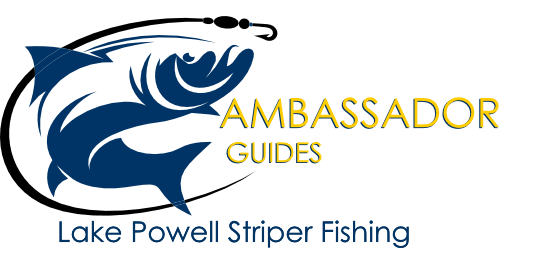Lake Powell Fish Report – May 14, 2013
Lake Elevation: 3596
Water Temperature 65-72 F
By: Wayne Gustaveson
Warmwater fish really respond to changes in water temperature. Lake Powell water temperature is now ranging from 65-72F meaning that spring fishing responses are on the way out and summer personality traits are setting in.
The most noticeable sign of warming water is the appearance of phytoplankton which gives lake water a green hue. Formerly crystal clear water now has much less visibility. Normally we blame runoff for clouding the water but this year runoff has just barely started and clarity is lessened by plankton.
It is time to say good bye to spawning bass and crappie. There were still some active nests this past week but the bass spawn is concluding now. Bass fishing is not over; it just changes to summer mode. Nest builders are leaving the shallows to go deeper. Wise anglers will adjust and do the same following the bigger bass to 15-25 feet. Crappie will move to open water and suspend making them harder to find but susceptible to slow trolling with small plastic grubs.
Fishing Tip: Free floating Carolina rigged baits behind a sliding sinker are more effective in the summer. Use the same plastic grubs, tubes and senkos, just rig them differently for more consistent success. Follow the 25-foot depth contour for best success.
Smallmouth bass will be fun and easy to catch in the shallow rocks all along the shore. But if you prefer the bigger fish then the advice just given about fishing deeper should be heeded. Big smallmouth are moving deeper once they leave the nest and will be caught at 25 feet as the water temperature climbs into the upper 70s.
Stripers will continue to hang out on the canyon walls until shad spawn and fry grow large enough to become striper food. For the remainder of the month stripers will continue to be caught like crazy with bait in the southern lake. Right now each shallow ledge extending out to 20 feet then falling into deep water holds a striper school. Stripers are eating plankton in the surface layer and crayfish on the 20 foot ledge while waiting for shad to appear.
Hot fishing spots are found all over Padre Bay. Good camping beaches often have a striper school nearby that can be caught from shore. Locate stripers by slow trolling lures in the upper 30 feet while graphing to find a school. When a striper is caught or a school seen on the graph, toss out a handful of chum and go to work. Stripers will rise to the chum but can be caught on an assortment of lures. Anchovies are a sure thing but everything from fly fishing to bottom bouncing works to catch these hungry fish. Please keep all the stripers you can use or give away to family and friends. It is population adjustment time and the southern lake will benefit from a smaller striper population.
Some stripers are still in the backs of canyons and easy to find and catch. Just work the mudline or color changes from brown to green water. Troll medium to deep divers at the color change where bottom depth is between 20 and 45 feet. Fishing is not as fast as that found on the canyon walls but stripers caught will generally be larger and fatter.
Walleye are enjoying the greener/murkier water and not very patiently waiting for shad to spawn. They are eating anything they can find all day long. Walleye fishing success will be at its peak for the next two weeks. The most effective technique this week was to put a night crawler on a quarter ounce jig head and slowly drag it along the bottom in 12-26 feet of colored water. The technique can be dressed up with worm harnesses, beads, spinners and bottom bouncers but the message here is that walleye are hungry and willing right now. There are more walleye north of Bullfrog than south but many are being caught all over the lake. That will continue for the rest of the month.
The muddy water near White and Farleys Canyon was great for walleye and fat stripers earlier in the month but runoff is now starting which will reduce visibility to zero, cool the water and reduce fishing success. The backs of canyons will provide better fishing than the main channel on the far north end of the lake.



